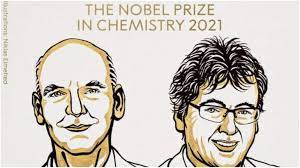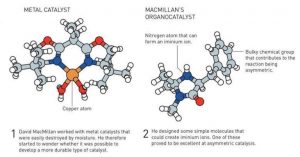08 Oct 2021 Nobel Prize in Chemistry: 2021

- The 2021 Nobel Prize in Chemistrywas awarded to Benjamin List and David W C MacMillan “for the development of asymmetric organocatalysis”.
Firstly, what is a catalyst? And what is catalysis?
- A catalyst is a substance that increases the rate of a chemical reaction without taking part in the reaction, or without undergoing any changes during the chemical reaction.
- Catalysis is the process of increasing the rate of a chemical reaction by adding a catalyst.
The major types of catalysts are metals and enzymes.
- Contributions of 2021 Nobel Prize Winners- asymmetric organocatalysis:
- In 2000, Dr. List and Dr. MacMillan, independent of each other, developed a third type of catalysis named asymmetric organocatalysis.
- The new catalysts, derived from naturally-occurring chemicals, were greener and cheaper, and ensured that the end product of the chemical reaction was of a specific variety — and did not need to go through a purification process to yield the desired type of compound.
How does it work?
- Organocatalysts bind to the reacting molecules to form short-lived intermediates that are more reactive than the substrate molecules on their own. Being chiral, the catalyst transfers its handedness to the substrate, controlling which side of the intermediate can react further.

Applications of organocatalysis:
- Organocatalysis finds several applications in pharmaceutical research and other industries.
- It has helped streamline the production of existing pharmaceuticals, including paroxetine, used to treat anxiety and depression, and oseltamivir, a respiratory infection medication.


No Comments